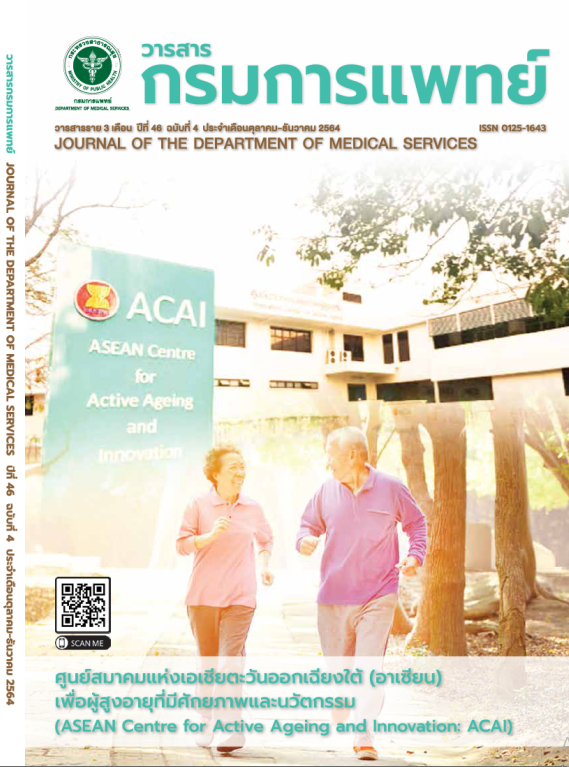ความชุกของความเสี่ยงต่อภาวะสำลักอาหารหรือน้ำเข้าปอดในผู้ป่วยเด็กที่ได้รับการผ่าตัดแบบไม่เร่งด่วนโดยใช้เครื่องตรวจคลื่นเสียงความถี่สูงของกระเพาะอาหาร
คำสำคัญ:
การตรวจกระเพาะอาหารด้วยเครื่องตรวจคลื่นเสียงความถี่สูง, ปริมาตรกระเพาะอาหาร, สิ่งตกค้างในกระเพาะอาหาร, การระงับความรู้สึกผู้ป่วยเด็ก, ภาวะสำลักอาหารหรือน้ำจากกระเพาะอาหารเข้าปอดบทคัดย่อ
ภูมิหลัง: ในการระงับความรู้สึก ภาวะสำลักอาหารหรือน้ำจากกระเพาะอาหารเข้าปอด (pulmonary aspiration) เป็นภาวะ แทรกซ้อนที่รุนแรง ถึงแม้พบได้น้อยแต่อาจเป็นอันตรายร้ายแรงแก่ผู้ป่วยได้ ปัจจัยที่ทำให้เกิดภาวะสำลักมีมากมาย โดยสิ่งตกค้างในกระเพาะอาหารถือเป็นปัจจัยที่สำคัญการนำเครื่องตรวจคลื่นเสียงความถี่สูง (ultrasound) ที่ใช้กันอย่างแพร่หลายในทางวิสัญญี มา ตรวจดูสิ่งตกค้างในกระเพาะอาหารก่อนเริ่มระงับความรู้สึก ทำให้สามารถค้นหาผู้ป่วยที่มีความเสี่ยงสูงต่อภาวะสำลักอาหารหรือน้ำเข้าปอดอันเนื่องจากมีสิ่งตกค้างในกระเพาะอาหารปริมาณมากได้ส่งผลให้ผู้ป่วยได้รับการดูแลที่เหมาะสมและปลอดภัยมากยิ่งขึ้นวัตถุประสงค์: เพื่อหาอัตราชุกของผู้ป่วยที่เสี่ยงต่อภาวะสำลักอาหารหรือน้ำจากกระเพาะอาหารเข้าปอด ในผู้ป่วยเด็กที่งดน้ำและอาหารตามแนวทางมาตรฐานเพื่อรับการผ่าตัดแบบไม่เร่งด่วน โดยใช้เครื่องตรวจคลื่นเสียงความถี่สูงวิธีการ: เป็นการศึกษาโดยการสังเกตเชิงพรรณนาแบบตัดขวาง ในผู้ป่วยเด็กอายุ 1- 15 ปี ASA physical status I-II จำนวน 256 ราย ทำการตรวจกระเพาะอาหารโดยใช้ เครื่องตรวจคลื่นเสียงความถี่สูงในท่านอนหงายและนอนตะแคงขวาก่อนเริ่มระงับความรู้สึกทั่วร่างกาย โดยดูลักษณะสิ่งตกค้างในกระเพาะอาหารและแบ่งระดับสิ่งตกค้างในกระเพาะอาหารเป็น 3 ระดับ (0-2) รวมถึงคำนวณปริมาตรกระเพาะอาหารเทียบกับน้ำหนักตัวจากการวัดพื้นที่หน้าตัด antrum ผู้ป่วยที่จัดเป็นกลุ่มเสี่ยง ต่อภาวะสำลักคือมีปริมาตรกระเพาะอาหารมากกว่า 1.25 มล.ต่อ กก. หรือมีสิ่งตกค้างในกระเพาะอาหารเป็นของแข็ง ผู้วิจัยแจ้งผลการตรวจทุกรายให้วิสัญญีแพทย์เจ้าของไข้ทราบทันทีก่อนเริ่มระงับความรู้สึก และมีการเก็บข้อมูล เช่น อายุ เพศ BMI ระยะเวลางดน้ำหรืออาหาร ASA status ระดับสิ่งตกค้างในกระเพาะอาหารอย่าง ง่าย ปริมาตรกระเพาะอาหาร นำไปวิเคราะห์ทางสถิติผล: อัตราชุกของผู้ป่วยที่เสี่ยงต่อภาวะสำลักอาหารหรือน้ำจากกระเพาะอาหารเข้าปอดคิดเป็นร้อยละ 6.6 ค่ามัธยฐานของระยะเวลางดน้ำเท่ากับ 10 ชั่วโมง และระยะเวลางดอาหารหรือนมเท่ากับ 10.5 ชั่วโมง ค่ามัธยฐานของปริมาตรกระเพาะอาหารเท่ากับ 0.7 มล.ต่อกก. ไม่มีผู้ป่วยรายใดที่มีสิ่งตกค้างในกระเพาะอาหารเป็นของแข็ง รวมถึงไม่มีผู้ป่วยที่เกิดภาวะสำลักอาหารหรือน้ำจากกระเพาะอาหารเข้าปอด
สรุป: อัตราชุกของผู้ป่วยเด็กสุขภาพดีที่เข้ารับผ่าตัดแบบไม่เร่งด่วนที่เสี่ยงต่อภาวะสำลักอาหารหรือน้ำจากกระเพาะอาหารเข้าปอดเท่ากับร้อยละ 6.6 การใช้เครื่องตรวจคลื่นเสียงความถี่สูงเพื่อหาปริมาตรกระเพาะอาหารทำได้ง่าย รวดเร็ว และนำมาใช้ได้จริงในทางวิสัญญี
เอกสารอ้างอิง
Borland LM, Sereika SM, Woelfel SK, Saitz EW, Carrillo PA, Lupin JL, et al. Pulmonary aspiration in pediatric patients during general anesthesia: incidence and outcome. J Clin Anesth 1998; 10: 95-102.
Walker RW. Pulmonary aspiration in pediatric anesthetic practice in the UK: a prospective survey of specialist pediatric centers over a one-year period. Paediatr Anaesth 2013; 23: 702-11.
Tan Z, Lee SY. Pulmonary aspiration under GA: a 13-year audit in a tertiary pediatric unit. Paediatr Anaesth 2016; 26: 547-52.
Bunchungmongkol N, Somboonviboon W, Suraseranivongse S, Vasinanukorn M, Chau-in W, Hintong T. Pediatric anesthesia adverse events: the Thai Anesthesia Incidents Study (THAI Study) database of 25,098 cases. J Med Assoc Thai 2007; 90: 2072-9.
Rawlinson E, Minchom A. Pulmonary aspiration. Anaesth Intensive Care Med 2007; 8: 365-7.
American Society of Anesthesiologists. Practice guidelines for preoperative fasting and the use of pharmacologic agents to reduce the risk of pulmonary aspiration: application to healthy patients undergoing elective procedures: an updated report by the American Society of Anesthesiologists Task Force on Preoperative Fasting and the Use of Pharmacologic Agents to Reduce the Risk of Pulmonary Aspiration. Anesthesiology 2017; 126: 376-93.
Schmitz A, Thomas S, Melanie F, Rabia L, Klaghofer R, Weiss M, et al. Ultrasonographic gastric antral area and gastric contents volume in children. Paediatr Anaesth 2012; 22: 144-9.
Tomomasa T, Tabata M, Nako Y, Kaneko H, Morikawa A.
Ultrasonographic assessment of intragastric volume in neonates: factors affecting the relationship between intragastric volume and antral cross-sectional area. Pediatr Radiol 1996; 26: 815-20.
Spencer AO, Walker AM, Yeung AK, Lardner DR, Yee K, Mulvey JM, et al. Ultrasound assessment of gastric volume in the fasted pediatric patient undergoing upper gastrointestinal endoscopy: development of a predictive model using endoscopically suctioned volumes. Paediatr Anaesth 2015; 25: 301-8.
Bouvet L, Bellier N, Gagey-Riegel AC, Desgranges FP, Chassard D, Queiroz-Siqueira M. Ultrasound assessment of the prevalence of increased gastric contents and volume in elective pediatric patients: A prospective cohort study. Paediatr Anaesth 2018; 28: 906-13.
Desgranges FP, Gagey Riegel AC, Aubergy C, de Queiroz Siqueira M, Chassard D, Bouvet L. Ultrasound assessment of gastric contents in children undergoing elective ear, nose and throat surgery: a prospective cohort study. Anaesthesia 2017; 72: 1351-6.
Song IK, Kim HJ, Lee JH, Kim EH, Kim JT, Kim HS. Ultrasound assessment of gastric volume in children after drinking carbohydrate-containing fluids. Br J Anaesth 2016; 116: 513-7.
Cubillos J, Tse C, Chan VW, Perlas A. Bedside ultrasound assessment of gastric content: an observational study. Can J Anaesth 2012; 59: 416-23.
Bouvet L, Mazoit JX, Chassard D, Allaouchiche B, Boselli E, Benhamou D. Clinical assessment of the ultrasonographic measurement of antral area for estimating preoperative gastric content and volume. Anesthesiology 2011; 114: 1086-92.
Bouvet L, Desgranges FP, Aubergy C, Boselli E, Dupont G, Allaouchiche B, et al. Prevalence and factors predictive of full stomach in elective and emergency surgical patients: a prospective cohort study. Br J Anaesth 2017; 118: 372-9.
Perlas A, Davis L, Khan M, Mitsakakis N, Chan VW. Gastric sonography in the fasted surgical patient: a prospective descriptive study. Anesth Analg 2011; 113: 93-7.
Perlas A, Mitsakakis N, Liu L, Cino M, Haldipur N, Davis L, et al. Validation of a mathematical model for ultrasound assessment of gastric volume by gastroscopic examination. Anesth Analg 2013; 116: 357-63.
Van de Putte P, Vernieuwe L, Jerjir A, Verschueren L, Tacken M, Perlas A. When fasted is not empty: a retrospective cohort study of gastric content in fasted surgical patients. Br J Anaesth 2017; 118: 363-71.
Van de Putte P, Perlas A. Ultrasound assessment of gastric content and volume. Br J Anaesth 2014; 113: 12-22.
Perlas A, Arzola C, Van de Putte P. Point-of-care gastric ultrasound and aspiration risk assessment: a narrative review. Can J Anaesth 2018; 65: 437-48.
Cook-Sather SD, Liacouras CA, Previte JP, Markakis DA, Schreiner MS. Gastric fluid measurement by blind aspiration in paediatric patients: a gastroscopic evaluation. Can J Anaesth 1997; 44: 168-72.
Pasunon P. Evaluation of Inter-Rater Reliability Using Kappa Statistics. The Journal of Faculty of Applied Arts 2015; 1: 2-20.
Brady M, Kinn S, O’Rourke K, Randhawa N, Stuart P. Preoperative fasting for preventing perioperative complications in children (Review). Cochrane Database Syst Rev 2005; 7: CD005285.
Mesbah A, Thomas M. Preoperative fasting in children. BJA Educ 2017; 17: 346–50.
ดาวน์โหลด
เผยแพร่แล้ว
รูปแบบการอ้างอิง
ฉบับ
ประเภทบทความ
สัญญาอนุญาต
ลิขสิทธิ์ (c) 2022 กรมการแพทย์ กระทรวงสาธารณสุข

อนุญาตภายใต้เงื่อนไข Creative Commons Attribution-NonCommercial-NoDerivatives 4.0 International License.
บทความที่ได้รับการตีพิมพ์เป็นลิขสิทธิ์ของกรมการแพทย์ กระทรวงสาธารณสุข
ข้อความและข้อคิดเห็นต่างๆ เป็นของผู้เขียนบทความ ไม่ใช่ความเห็นของกองบรรณาธิการหรือของวารสารกรมการแพทย์



